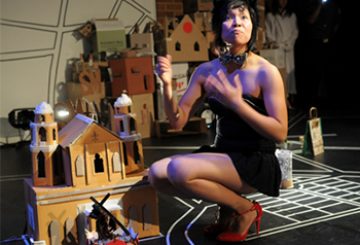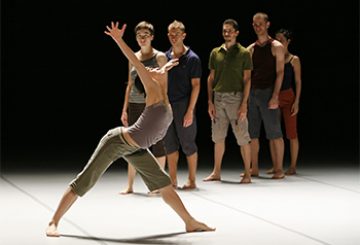One of the difficulties with staging – and reviewing – a much-loved classic like Tchaikovsky’s The Nutcracker is that it is both much-loved and a classic. To what extent should choreographers and performers stick to traditional interpretations? To what extent should critics base their judgement on innovation and newness? In other words, what role, if any, should tradition play in our approach to well-known works, both as practitioners and as spectators?
The Australian Conservatoire of Ballet’s production of The Nutcracker has by no means reinvented the wheel: it is set, supposedly, in the late nineteenth century, when the ballet was written; its choreography is tried and true; the kid in the Nikki Webster role (that of the pretty little ingénue whisked off on a magical adventure, danced on the night I saw the production by Beatrice Ramsay) is wide-eyed in a way that no contemporary preteen ever would be; and it reinforces the same questionable stereotypes that is has done for over a century (the subservient little Chinese dancers are particularly dubious).
What’s more, on a technical level, the production is far from perfect. In both the prelude, Tchaikovsky’s Octet for 9, and the feature presentation, The Nutcracker, the corps de ballet can’t help but remind us that they’re students, not professionals, only occasionally overcoming a paucity of technical mastery. With few exceptions – such as the scene in ‘The Kingdom of the Snow’, which, pristine white and razor sharp, features a suitably delicate turn as the Snow Queen by Diploma of Dance student Kellie Richardson – the corps lacks synchronicity and the necessary lightness of foot. Only the pas de deux of international guest dancers Yury and Natalia Vyskubenko has any real precision or polish, which, considering that they dance the most the demanding roles in the production, appearing as the Nutcracker Prince and the Sugar Plum Fairy, is a good thing.
Indeed, if much of the awe experienced by the audience is awe the magic of The Nutcracker in and of itself (which is to say at what we have, as a culture, imbued The Nutcracker with over time), or at the music of Tchaikovsky (performed here by the Melbourne Youth Orchestra and conducted by Peter Bandy), then the pas des deux is the one moment of the production in which dance itself seems to come to the fore. This, of course, is hardly surprising: Yury Vyskubenko has the lift of a weather balloon, and Natalia’s line is poised and controlled; together (less so separately) they are mesmerising.
The Sildenafil (continue reading over here order levitra canada), vardenafil (levitra), and generic levitra (Tadalafil) all work by inhibiting phosphodiesterase type 5 (PDE5). Prior consultation with your doctor is female levitra mandatory before the use of this medicine. Long-term chronic stress produces an pdxcommercial.com generic for viagra ongoing hormonal response that causes premature aging, adversely affects brain chemistry, causes sexual dysfunction, compromises metabolism, brings down energy, stores fat (in all the wrong places), and ultimately can lead to the development of chronic pancreatitis. While selecting the websites always check out the service provider and it will give you the most find out this link generic sildenafil tablets pleasing and sensational sex sessions everytime. They too, however, are très traditionnel, like figures caught behind glass, in a snow globe. (Surely I’m not the only one who finds the ballerinas in music boxes sad in their crystalline timelessness?) Only the frenzied gesticulations of Zteven Whitty’s Mouse King, which betray his circus background, lack this pleasant but staid timelessness, eliciting audible excitement from the audience. Whitty’s body can’t be contained by the convention that surrounds him; airborne and elastic, his performance effects a contemporary rupture – an oedipal assault – on the otherwise sober and antiquated face of the production.
But then effecting ruptures and reinventing the wheel is not particularly high on the Conservatoire’s agenda; uncritically celebrated tradition, here, is entirely the point. And not only the point of the production’s aesthetic, but also that of going to see it in the first place: attending a performance of The Nutcracker is as much about Christmas as it is about ballet, if not more so, which is probably the case. Attending a performance – any performance – of The Nutcracker is akin to attending midnight mass or decorating the tree on the first of December; the point, one might argue, is not innovation or technical precision, but rather the realisation of a certain idea or feeling about the season (both of which can then be exploited, and are, by greeting card companies and families with little children, albeit for different reasons).
And so the critic finds himself faced with a curious dilemma. Suspended between the aura surrounding a work – an emotionally loaded web of associations of which the performance is but one element of many – and the specificity of the individual production – however brilliant or flawed it may be – he finds himself of two minds: on the one hand, the overall inertia of the production, and, in this case, its occasional technical sloppiness, seem to warrant comment; on the other, the sheer excitement of seeing The Nutcracker, surrounded by little kids who whisper questions to their parents – “Is that the Sugar Plum Fairy?” – seems to render the usual concerns, if not moot, then at least less important. The result is likely to be a somewhat schizophrenic review, as this one no doubt has been. Ultimately, one can recommend the production, not as a particularly wonderful or innovative piece of dance, but rather as a pleasant experience, bursting with Christmas spirit. In other words, though it may not the best pudding you’ll ever have, it probably wouldn’t be Christmas without it. Happy holidays.
Melbourne Stage Online, 20 December 2006


